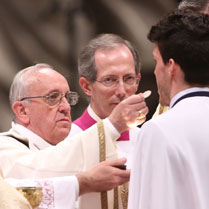Meditatio is the second step in praying with the scriptures. The word is most obviously translated as meditation.
But the popular conception of ‘meditation’ is an Eastern conception which evokes ‘mindfulness’ or some other variation of emptying the mind. St Teresa of Avila warns against such practices:
“Some books advise that as a preparation for hearing what our Lord may say to us we should keep our minds at rest, waiting to see what He will work in our souls. But unless His Majesty has begun to suspend our faculties, I cannot understand how we are to stop thinking, without doing ourselves more harm than good.”
The Interior Castle, chapter 3
Christian meditatio is almost the direct opposite of Eastern meditation.In meditatio, the mind seeks to understand the mysteries of God. Far from emptying the mind, we engage with our reason and our imagination.
Scriptural meditatio is, I think, rather straightforward and easy for us moderns. It’s not much different to reading a newspaper and thinking about what we’ve read. Analysing it. Contemplating consequences. That’s engaging reason.
Or we can engage the imagination. The most famous proponent of imaginative meditatio is St Ignatius of Loyola. In more recent times, another Spanish saint — a compatriot of St Ignatius and St Teresa — and like them a holy founder, also practiced and encouraged imaginative meditatio. Here is St Josemaría Escriva’s description of meditatio:
“My advice is that, in your prayer, you actually take part in the different scenes of the Gospel, as one more among the people present. First of all, imagine the scene or mystery you have chosen to help you recollect your thoughts and meditate. Next apply your mind, concentrating on the particular aspect of the Master’s life you are considering — his merciful Heart, his humility, his purity, the way he fulfils his Father’s Will. Then tell him what happens to you in these matters, how things are with you, what is going on in your soul. Be attentive, because he may want to point something out to you, and you will experience suggestions deep in your soul, realising certain things and feeling his gentle reprimands.
“Make it a habit to mingle with the characters who appear in the New Testament. Capture the flavour of those moving scenes where the Master performs works that are both divine and human, and tells us, with human and divine touches, the wonderful story of his pardon for us and his enduring Love for his children. Those foretastes of Heaven are renewed today, for the Gospel is always true: we can feel, we can sense, we can even say we touch God’s protection with our own hands; a protection that grows stronger as long as we keep advancing despite our stumbles, as long as we begin again and again, for this is what interior life is about, living with our hope placed in God.”
Friends of God, 253, 216
Whether you’re more analytical or more imaginative, I think meditatio is very attractive and easy way for us to pray. It leads directly into the third step, oratio, but that’s a post for another day.






Recent Comments